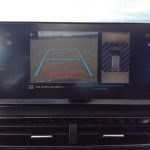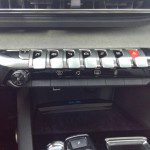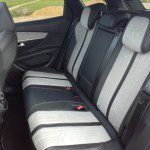It became a millionaire during the summer. The second generation Peugeot 3008 has in fact passed the symbolic mark of one million units produced at the Stellantis factory in Sochaux, France. Although the figure remains modest compared to the sales of the iconic 205 and 206, it would be unfair not to call it a success story. And it makes sense when you realize that the SUV has been on the market since 2016, a pittance compared to the 206, which has been present in the brand’s European dealerships for fifteen years. In 2020, the 3008 has been given a makeover with the traditional mid-career restyling. Will the changes be enough to keep the king on his throne?
Portrait – A visible rhinoplasty
The saying goes that you don’t change a winning team. But Peugeot has done it. For what is supposed to be a simple restyling, the 3008 gets a completely new face. The SUV refines its headlights and gains the luminous fangs initiated by the 508 and taken up by the whole Peugeot range. The front grille features evolving spikes and offers a particularly successful floating effect at the ends. The 3008 logo appears on the end of the bonnet. The black lacquered side scoops placed under the lights visually widen the vehicle. From the side, the differences are limited to the appearance of new wheel sets on the top-of-the-range versions. The changes to the rear end are more subtle than those to the front, but are still very visible. The taillights are now integrated into a smoked window and are much more elaborately shaped than before. The LEDs provide an elegant 3D effect, while there are scrolling indicators. All trims also feature LED number plate illumination. Our version is equipped with the Black Pack option, which transforms all the chrome into black lacquer, satin, matte and varnish elements. The 19-inch black wheels are also specific. For the rest, the 3008 remains the 3008, with a dynamic silhouette with sharp angles taken from the Quartz concept car from 2014.
In the cabin – A slightly redesigned dashboard
Contrary to the exterior, which – for a restyling – plays the revolutionary card, the interior receives modest modifications. This is not a bad thing because the i-Cockpit, a real Peugeot trademark since the first 208, brings a real breath of fresh air compared to the competition. The small steering wheel with the instrument cluster in a high position is once again present. For the restyling, this instrument cluster adopts the Normally Black technology which allows for deeper blacks and a better contrast between the colours. While the i-Cockpit is visually stunning, the driving position can be a bit of a challenge for some drivers. We didn’t find this to be a problem because in our case the top of the steering wheel doesn’t hide the clusters at all. In the middle is the most noticeable change, which is the digital display, which is a good 10 inches in size, except for the entry-level model, which retains the 8-inch screen of the pre-restyling models. The piano keys are part of the design, as is the imposing central console, which reinforces the cockpit aspect of the cabin. The more observant will also have noticed the arrival of a frameless rear view mirror. The assemblies are of good quality and the materials used are meticulous, especially on the GT Pack trim of our model, which features TEP and Greval Grey Alcantara on the seats, dashboard and door panels. Overall, the build quality is superior to that of the Volkswagen Tiguan. A few hard plastics remain on lower parts and on the top of the rear doors, but generally speaking, the whole thing bears the weight of the years very well.
What has not aged well, however, is the infotainment system. A real drawback of the 3008, the system appears to be very behind the competition. The screen is not very responsive, the functions are limited and the graphics are dated. Fortunately, Apple CarPlay and Android Auto compatibility make up for many of these shortcomings. While this is good news, your smartphone screen will be displayed on an 8-inch diagonal, with the system permanently reserving two side bars as shortcuts for ventilation. It’s mainly when reversing that it gets annoying. The rear view camera has a very average resolution. The same applies to the 360° vision system, which is actually equipped with two cameras. It simply memorizes the front and rear environment and draws a vague picture of it as the vehicle moves. On the whole, the interface did not convince us, especially on the top of the range vehicle that is this 3008 GT Pack. We can’t wait for the new interface from the Stellantis group, which was introduced in the new 308 and DS4!
If the infotainment system is not as good as the competition, music lovers will be won over by the Focal sound system with 10 speakers and 515 W delivering a very good quality high-fidelity sound. The nightclub atmosphere is further enhanced by the blue ambient lighting in the door panels. This light is projected onto the side inserts, but cannot be customized and comes in a single colour. In terms of ergonomics, the 3008 is still not a benchmark. Grouping the ventilation controls solely via the touch screen remains impractical, despite the aforementioned piano keys and side bars. The cruise control and speed limiter are hidden behind the steering wheel and take some getting used to, and can interfere with the indicator switch. Storage is plentiful, with felt-covered storage compartments and a very deep, refrigerated centre bin under the front armrest. The cupholders are located just in front of the armrest and can be a problem on manual transmission models. Finally, there is a smartphone slot with an induction charger at the front of the centre console, as well as a USB-A and a 12V socket.
Moving to the rear, you are pleasantly surprised at first by the matte door sound giving a great quality feel. Legroom is good, as is headroom. The middle passenger will be delighted by the absence of a transmission tunnel but will have to deal with a firmer backrest and a more restricted space, because of the bench seat. In this respect, a Skoda Karoq is more welcoming with a sliding bench and aviation shelves on the back of the front seats. The 3008 can counter with large air vents, a 12V socket and two USB-A sockets for the rear occupants.
With a wide opening and a low sill, the boot is practical and can be opened via a hands-free powered tailgate on the top-of-the-range versions. Its volume is also a benchmark at 520 litres and its modular floor means that you can avoid having a step once the rear seat is folded down by using the handles on the sides. In addition, there are additional storage compartments on the sides, as well as tie-down hooks and a 12V socket. In the plug-in hybrid version, the boot is reduced to 395 litres, but the rear passenger compartment is preserved. The flat floor disappears, the batteries having taken up residence under the rear seat. There are a few small touches, such as a chrome-plated false floor handle. However, LED lighting in the loading area would have been welcome for a more modern look.
On the road – When electrification enhances the driving experience
Push the ignition switch and…no noise except for a small beep confirming that the vehicle has started. The 3008 HYBRID almost always starts in electric mode. Remember that our test model combines the 1.6 PureTech 180 with a 110 PS electric motor for a cumulative power of 225 PS sent to the front wheels. Depending on the charge of the 13.2 kWh battery (10.8 kWh useful) and the driving style adopted, it is possible to drive up to 135 kph (83 mph) without waking up the combustion engine, particularly with the Electric mode, forcing the car to drive on electricity. We also noted a range of 48 km (30 mi) on an extra-urban journey with a little eco-driving, a score not so far from the 56 km (35 mi) announced by Peugeot. The Hybrid mode offers a compromise between electric and petrol power to optimise fuel consumption. The 3008 does not hesitate to put its internal combustion engine off at a standstill, at low speed and during deceleration. Finally, the Sport mode makes the electric and combustion engines work together to give the best possible performance (0-60 in 8.7 seconds and a 225 kph (140 mph) top speed). As for charging, the 3008 HYBRID is supplied with a 3.7 kW Type 2 connector allowing a full battery in 6 hours. An optional 7.4 kW charger reduces the charging time to 2 hours.
In town, the Peugeot reassures its driver with its compact dimensions (4.47 m long and 1.84 m wide), its large rear-view mirrors and its bonnet which is clearly visible from the driving position. Peripheral visibility, however, is average with thick A-pillars and a ¾ rear view disturbed by a high beltline. Despite this, the 3008 remains easy to handle in urban environments thanks to its light steering and small turning circle (10.6m between kerbs). However, the braking is not easy to control and requires a little time to adapt. The transition from regenerative brakes (B-mode) to friction brakes is not very smooth and can be surprising. This problem is common to most hybrid and electric cars. Conversely, the electric-thermal combination performs wonders. Evolutions in traffic jams are seamless while the instantaneous torque provided by the electric motor makes roundabout insertions a formality. As far as damping is concerned, the 3008 seems a little firm at low speeds with sometimes harsh reactions on speed bumps and manhole covers.
It is on winding roads that the 3008 displays all its talent. Linked to a particularly precise and gripping front end, the small steering wheel transforms cornering into a real pleasure, which was not easy to achieve for an SUV. Despite the extra weight of the batteries (1,761 kg in total), the vehicle remains agile, understeer appears late and the rear axle also winds up the curves brilliantly, allowing for a playful drive. The seats also hold the occupants quite well. Of course, if the speed increases, the 3008 tends to sag on sharp bends, the price of a quite soft suspension. In this area, only a Ford Kuga (Escape) can match the French, which remains a reference. And in terms of comfort, the lion’s SUV is also very good, even on very rough roads, even if it doesn’t offer the softness of a Citroën C5 Aircross. The e-EAT8 electrified gearbox shifts smoothly and downshifts at the right moment to keep the optimum gear for sporty driving.
On the motorway, the 3008 proves to be a very good travelling companion with a careful soundproofing. Road noise is almost inaudible and wind noise is barely present. At high speeds, the car feels stable and few corrections are needed to stay in the centre of the lane. The damping is also top-notch on large undulations and other road junctions. The Drive Assist Plus package, which allows level 2 semi-autonomous driving, is quite effective and also works in roadworks zones with sometimes hazardous markings. Its Stop&Go function is also very useful in stop-and-go traffic. In terms of fuel consumption, the 3008 HYBRID does well with an average of 7.1 l/100 km (39.7 mpg) on a motorway journey with the battery discharged. The competitors are much more thirsty. In hybrid mode, the results are just as good, with an average of 4.8 l/100 km (58.8 mpg) on a mixed route. Only the 43-litre tank (53 litres for the purely internal combustion versions) will increase the frequency of refuelling on the motorway.
Competition
Priced from €32,350 in France, the Peugeot 3008 is more expensive overall than the mainstream competition, even if its basic equipment is also slightly more extensive. Our test model in the top-of-the-range GT Pack trim with the HYBRID 225 powertrain costs at least €50,200. It is therefore more expensive than its technical cousins Opel Grandland Ultimate (225 PS, €47,750) and Citroën C5 Aircross Hybrid Shine Pack (225 PS, €45,450). With a few pleasant options such as the Ultimate Red paint (€850), night vision (€1,400), the Black Pack (€300) and the panoramic sunroof (€1,200), the final bill rises to €54,260. This high price automatically places our 3008 in the premium segment. The Audi Q3 e S line (245 PS, €51,370), BMW X1 xDrive 25e M Sport (220 PS, €52,250) and Mercedes GLA 250e AMG Line (218 PS, €51,599) charge similar sums but also offer a more prestigious badge. The more expensive Toyota RAV4 Plug-in Hybrid Collection (€58,100) offers four-wheel drive, 306 PS and, above all, a much greater electric range of 75 km (47 mi). At the other end of the scale, a Ford Kuga Plug-in Hybrid Vignale has similar technical characteristics to the Peugeot, but at a lower price (€47,000).
Conclusion
By relying on the electricity fairy, the 3008 further enhances the quality of its services. Its fundamentals of interior and exterior design, road handling and comfort remain. They are now joined by a welcome smoothness that is perfect for commuting, with substantial fuel savings at the end of the day. And savings will certainly be needed to make the high price of the vehicle worthwhile. If you’re a regular commuter and stick to a consistent recharging cycle, the 3008 HYBRID 225 is a genuine proposition. If you cover short distances during the year, the 3008 PureTech 130 is a good choice as it is much cheaper to buy and sufficiently sober. As for long-distance drivers, we can only urge them to opt for the BlueHDi 130 version, which is less greedy on the motorway and, above all, costs €6,700 less than the HYBRID 225.
Strengths
- Attractive presentation
- Great compromise between road handling and comfort
- Good fuel economy
Weaknesses
- Some models are costly
- Outdated infotainment system
- Optional equipment on top of the range trims
Verdict : 13.9/20
I would like to thank Peugeot France for lending me the vehicle, otherwise this review would not have been possible.

























